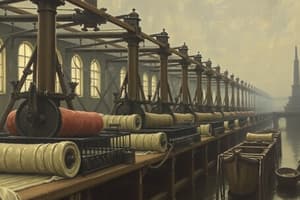Podcast
Questions and Answers
What industry initially sparked the Industrial Revolution in England?
What industry initially sparked the Industrial Revolution in England?
- Textile (correct)
- Agriculture
- Ironworking
- Transportation
Cotton textiles were more expensive to produce than wool or linen.
Cotton textiles were more expensive to produce than wool or linen.
False (B)
What was a significant technological advancement that increased productivity in factories during the late 18th century?
What was a significant technological advancement that increased productivity in factories during the late 18th century?
Steam power
England controlled an empire that covered _____ of the world’s landmass by 1750.
England controlled an empire that covered _____ of the world’s landmass by 1750.
Match the following textile materials with their characteristics:
Match the following textile materials with their characteristics:
Which of the following advancements allowed corporations to own and operate businesses effectively during the Industrial Revolution?
Which of the following advancements allowed corporations to own and operate businesses effectively during the Industrial Revolution?
Urbanization was directly linked to the rise of factory jobs in European cities.
Urbanization was directly linked to the rise of factory jobs in European cities.
What was a primary reason people moved to cities during the Industrial Revolution?
What was a primary reason people moved to cities during the Industrial Revolution?
What percentage of the population lived in urban areas in England in 1800?
What percentage of the population lived in urban areas in England in 1800?
Industrialization made cities less important as production centers.
Industrialization made cities less important as production centers.
How were preindustrial cities described by some historians?
How were preindustrial cities described by some historians?
In England, by 1900, approximately _____ percent of people were urban dwellers.
In England, by 1900, approximately _____ percent of people were urban dwellers.
Which of the following countries had the highest population densities between 1750 and 1914?
Which of the following countries had the highest population densities between 1750 and 1914?
What was one significant change that occurred in the lives of workers after the Industrial Revolution?
What was one significant change that occurred in the lives of workers after the Industrial Revolution?
Match the following terms with their descriptions:
Match the following terms with their descriptions:
Workers in new industrial cities often came home with little energy, space, or light to enjoy _____ or games.
Workers in new industrial cities often came home with little energy, space, or light to enjoy _____ or games.
Flashcards are hidden until you start studying
Study Notes
Overview of the Industrial Revolution
- Began in England around 1750, making it one of the wealthiest nations and controlling an empire covering one-quarter of the world's landmass.
- Originated in the textile industry, which needed to produce goods more cheaply and quickly due to growing consumer demands.
Textile Industry Innovations
- Hand-making cloth for domestic items was time-consuming and required skill.
- Population growth in England created a higher demand for textiles.
- Late 18th century saw key innovations by entrepreneurs and factory workers, leading to the establishment of factories for centralized production.
- Cotton textiles gained prominence due to their advantages: lower cost, strength, and easier coloring compared to wool or linen.
Technological Advancements
- Adaptation of steam power for machinery significantly increased productivity and efficiency in factories.
- Heavy industries, such as ironworking, underwent major reforms, driven by new technologies.
- Advances in transportation facilitated faster and further product distribution.
Economic and Legal Changes
- Business scale outgrew individual financial capacities, prompting legal reforms to allow corporate ownership of businesses.
- Scholars debate the most important factors behind England's lead in the Industrial Revolution but agree on the importance of multiple converging factors providing a technological and commercial edge.
Urbanization and Population Dynamics
- Industrialization coincided with rapid urban growth as people migrated to cities for factory jobs.
- Pre-Industrial cities described as "economically parasitic," consuming rural resources without reciprocal production.
- Post-Industrial cities became production centers, offering manufactured goods to rural areas.
- Urban population in England rose from 9 percent in 1800 to 62 percent by 1900, reflecting significant urbanization.
Social Impact on Workers
- Industrial cities became influential in transforming lives, affecting workers' conditions and expectations.
- Skilled workers, previously enjoying a middle-class lifestyle, faced deteriorating quality of life due to factory demands.
- Work-life balance shifted with reduced personal time for recreation: long working hours left little opportunity for leisure.
- New industrial routines clashed with traditional village festivals and community activities, altering social dynamics.
Studying That Suits You
Use AI to generate personalized quizzes and flashcards to suit your learning preferences.




